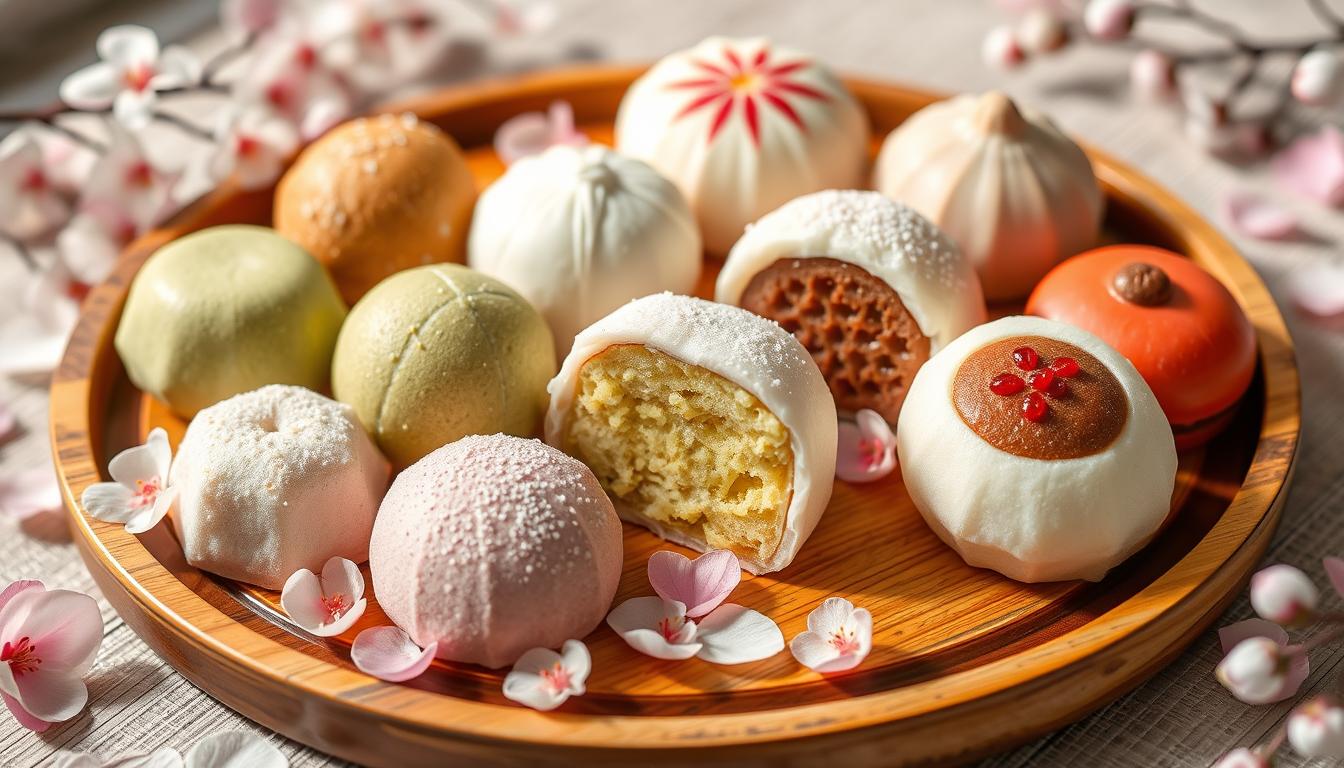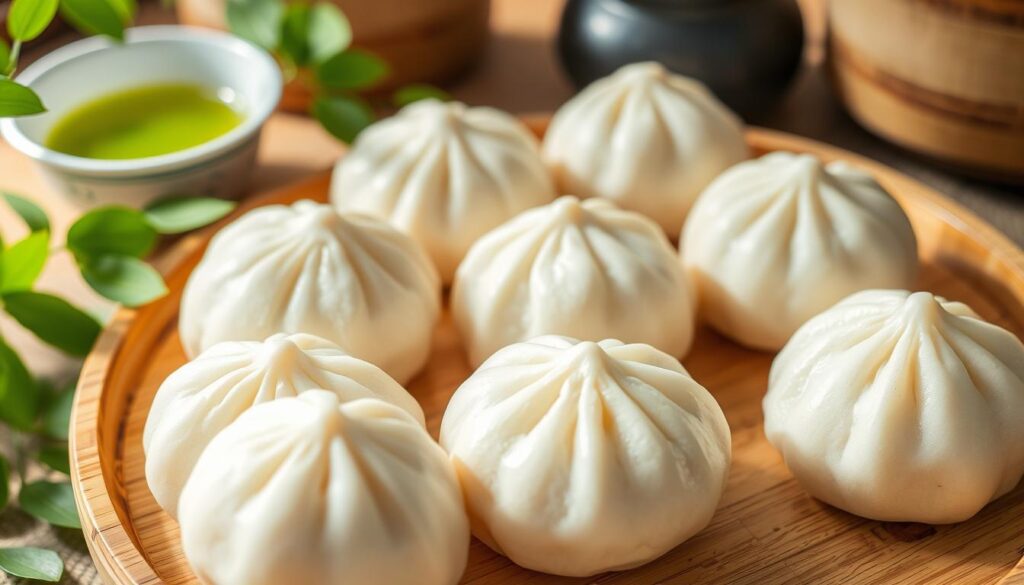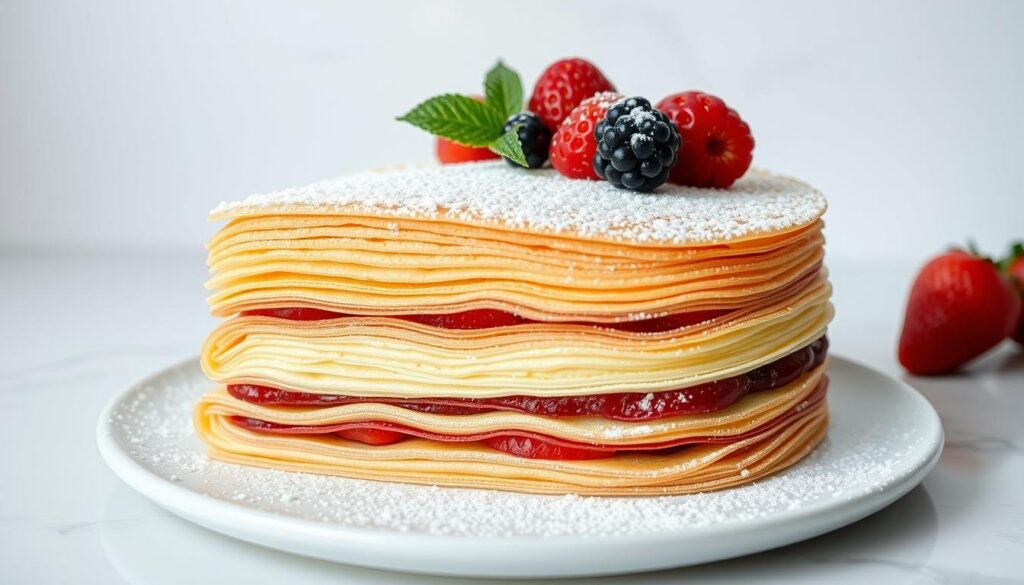Step into a world of delicate flavors and subtle sweetness. Your kitchen becomes a Japanese pastry haven. Homemade Japanese desserts offer a unique culinary journey. They go beyond traditional American sweets, inviting you to explore traditional wagashi with minimal ingredients and maximum satisfaction.
These sweet treats are more than recipes; they’re cultural experiences waiting to be discovered. From the delicate layers of a mille crepe cake to the soft texture of Hanami Dango, Japanese desserts add a unique touch to your home cooking. They bring simplicity and sophistication together.
Key Takeaways
- Japanese desserts typically use less sugar compared to American sweets
- Many traditional desserts require minimal ingredients
- Desserts like Hanami Dango can be prepared in around 30 minutes
- Homemade Japanese sweet treats pair perfectly with green tea
- Most recipes are beginner-friendly and adaptable
Introduction to Traditional Japanese Desserts
Explore the magical world of wagashi, Japanese sweets that turn simple ingredients into art. These traditional sweets are more than just desserts. They are a way to express Japan’s rich culture and creativity.
Japanese desserts have a long history, even before sugar was common. They use natural ingredients like rice, beans, and sweet potatoes. This shows Japan’s clever ways of cooking.
“Wagashi represents the harmony between flavor and aesthetic beauty in Japanese cuisine.”
- Ingredients often include red bean paste (anko), mochi, and plant-based components
- Sweets typically accompany green tea ceremonies
- Each region boasts unique confectionery specialties
The history of Japanese sweets goes back centuries, through the Edo to the Meiji era. Today, neo-wagashi mixes old ways with new, creating exciting tastes.
| Dessert Type | Key Ingredients | Cultural Significance |
|---|---|---|
| Sakuramochi | Rice, Red Bean Paste | Spring Festival Treat |
| Dorayaki | Azuki Beans, Flour | Popular Street Dessert |
| Taiyaki | Wheat Flour, Anko | Fish-Shaped Street Food |
If you love sweets or want to learn about culture, Japanese desserts are a tasty adventure. Each sweet has its own story, from local ingredients to seasonal changes and family traditions.
Essential Ingredients for Japanese Sweet Making
Exploring Japanese desserts introduces you to unique ingredients. These ingredients create amazing flavors. Your journey will uncover the magic that turns simple recipes into sweet wonders.
Japanese desserts need special ingredients for authentic tastes and textures. Learning about these key items will improve your cooking skills.
Common Sweet Bean Pastes and Fillings
Azuki beans are at the heart of many Japanese sweets. The most loved ingredient is anko, a sweet red bean paste made from these beans. Anko is found in many desserts, offering rich, smooth fillings that are a joy to eat.
- Traditional anko made from azuki beans
- Smooth and sweet red bean paste
- Versatile filling for multiple dessert styles
Special Flours and Starches
Mochiko, a glutinous rice flour, is key in Japanese sweets. It makes treats like mochi chewy and gives them a unique feel. This flour is what makes Japanese desserts special.
Traditional Sweeteners and Flavorings
Matcha powder is a star, adding green color and earthy taste to desserts. Sweeteners like mirin balance these flavors, making desserts taste nuanced and balanced.
Japanese desserts celebrate subtle sweetness through carefully selected ingredients and precise techniques.
Mastering these essential ingredients will let you make authentic Japanese sweets at home.
Basic Techniques for Japanese Sweet Food
Making authentic Japanese desserts needs you to learn a few key skills. These skills turn simple ingredients into tasty treats. Steaming, folding, rolling, and shaping are key to making traditional sweets in your kitchen.
Knowing these techniques helps you make delicate Japanese sweets with care. Each method is important for the texture, look, and taste of your desserts.
Key Techniques Explained
- Steaming: A gentle cooking method that keeps moisture in, making sweets like manju soft and delicate
- Folding: This is about mixing ingredients carefully to keep air in, making desserts light and airy
- Rolling: It’s about making thin, even layers for treats like crepe cakes and wagashi
- Shaping: This is about making detailed designs and traditional shapes found in Japanese sweets
“Mastering Japanese dessert techniques is an art that combines precision and creativity.” – Traditional Japanese Pastry Chef
Different sweets need different approaches to these techniques. For example, making mochi needs careful kneading and shaping. Dorayaki, on the other hand, requires precise folding of the batter.
| Technique | Dessert Example | Key Skill |
|---|---|---|
| Steaming | Manju | Maintaining moisture and soft texture |
| Folding | Souffle | Preserving air and lightness |
| Rolling | Mille Crepe Cake | Creating thin, uniform layers |
| Shaping | Wagashi | Crafting intricate designs |
With practice, you’ll get better at making beautiful and tasty Japanese desserts. These desserts will show off the beauty of this culinary tradition.
Manju: Classic Steamed Sweet Buns
Explore the world of soft manju, a traditional Japanese treat with a history of nearly 700 years. These tasty steamed cakes come from China and arrived in Japan in 1341. They quickly became a favorite across many generations.
Manju is special because of its soft and delicate texture. These anko-filled buns are round and just the right size for enjoying with green tea.
Preparing the Perfect Manju Dough
Making the perfect manju dough needs careful attention. The dough usually includes:
- All-purpose wheat flour
- Brown sugar
- Rice flour
- Optional ingredients like grated yams or miso
Tips for Sweet Bean Paste Filling
The filling is the heart of manju. Anko (sweet red bean paste) is the most loved, coming in two types:
- Koshian: Smooth, refined bean paste
- Tsubuan: Coarse, textured bean paste
But, bakers also try new fillings like:
- Green pea paste (uguisuan)
- White bean paste (shiroan)
- Matcha paste
- Fruit-based fillings (mango, strawberry)
Steaming Methods and Timing
Steaming is key to making manju soft and delicate. Steam the buns for about 10 minutes. This makes them soft and cake-like. They can be kept in the fridge for a day or frozen for a month.
Pro tip: The key to perfect manju lies in gentle handling and precise steaming techniques.
Taiyaki: Fish-Shaped Waffle Treats
Explore the world of taiyaki, the tasty fish-shaped pancakes loved in Japan and worldwide. These crispy waffles are more than a snack; they’re a mix of tradition and tasty creativity.
Taiyaki started in Tokyo in the early 1900s. It’s a favorite Japanese street food with a deep cultural history. The fish shape is not just for fun; it’s thought to bring luck and prosperity.
“Taiyaki is not just a dessert, it’s a piece of Japanese culinary art that fits in the palm of your hand.”
Filling Varieties
- Traditional red bean paste (anko)
- Creamy custard
- Matcha green tea
- Chocolate
- Sweet potato
- Seasonal fruit fillings
Each taiyaki has about 60 calories. It’s crispy outside and soft inside. You can find many fillings, from classic to new ones.
| Nutritional Information | Amount per Taiyaki |
|---|---|
| Calories | 60 |
| Fat | 2.5g |
| Carbohydrates | 7g |
| Protein | 1g |
Making taiyaki at home is simple. You need a fish-shaped pan, basic ingredients, and creativity. Whether you like traditional or new fillings, taiyaki is a tasty trip into Japanese street food.
Pro tip: The key to perfect taiyaki is maintaining consistent heat and generously oiling your molds!
Mille Crepe Cake: Japanese-Style Layered Dessert
The Japanese mille crepe cake is a mix of French patisserie and Japanese art. It turns simple pancakes into a fancy dessert. It will wow your guests and make your sweet tooth happy.
Making mille crepe cake needs precision and patience. The secret is in three main parts: making crepes, stacking them, and filling them with cream.
Layer Assembly Techniques
To make a beautiful mille crepe cake, layering is key. Here are some tips:
- Spread pastry cream evenly with a flat spatula between each crepe
- Make 25-30 very thin crepes
- Make sure each layer is the same thickness
- Chill it overnight to set the layers
Crepe Batter Secrets
The crepe batter is the base of a great mille crepe cake. For thin, soft pancakes, follow these tips:
- Cook on low heat (around setting 4 out of 10)
- Cook each crepe for 2-3 minutes
- Add water just before cooking for a thin batter
- Practice with “sacrificial” crepes to get better
Filling Variations
Try different pastry cream flavors to make your mille crepe cake unique. Some favorites are:
- Classic vanilla custard cream
- Matcha green tea cream
- Chocolate cream
- Lemon curd
- Cream cheese filling
Pro tip: Use heavy cream with a fat content of 36% or higher for the most stable and luxurious whipped cream filling.
Your homemade Japanese-style mille crepe cake will last up to a week in the fridge. This lets you enjoy it many times.
Purin: Japanese Custard Pudding
Purin is a silky dessert loved by many in Japan and around the world. It’s more than a simple flan. It’s a mix of smooth textures and delicate flavors that make it unforgettable.
Purin was introduced to Japan in the early Meiji period. It has become a favorite among children. Unlike Western puddings, it has a unique twist.
What Makes Purin Special?
- Smooth, creamy texture that melts in your mouth
- Rich caramel sauce that adds depth to the silky dessert
- Versatile flavors including chocolate, matcha, and sweet potato
Making purin right is all about the right mix of ingredients. You’ll need:
- Fresh eggs
- Whole milk
- Granulated sugar
- A touch of vanilla (optional)
“Purin is not just a dessert – it’s a piece of Japanese culinary art that tells a story of cultural fusion and culinary innovation.”
Here are some tips for making purin:
- Strain the custard mixture to ensure smoothness
- Remove air bubbles before baking
- Use a bain-marie for gentle, even cooking
- Avoid overheating to maintain the perfect texture
Purin is perfect for anyone who loves desserts or wants to try Japanese cooking. It’s easy to make and has a rich history. It’s sure to become a favorite in your kitchen.
Kasutera: Traditional Sponge Cake
The Castella cake is a beloved Nagasaki specialty with a history over 400 years old. It was introduced by Portuguese merchants in the 16th century. This honey sponge cake is a favorite Japanese dessert that shows the art of traditional sweet-making.
To understand Castella cake, you need to know its special features and how it’s made. Unlike other sponge cakes, it requires exact ingredients and baking techniques for its unique texture.
Achieving Perfect Texture
Creating a real Castella cake involves several important steps:
- Use bread flour for an elastic, bouncy texture
- Incorporate a higher ratio of egg yolks for rich flavor
- Whip egg whites to create optimal volume
- Add honey for moisture and distinctive sweetness
Baking Temperature Guide
Getting the baking right is key to making a great Castella cake. Traditional recipes suggest:
- Bake at 340°F (170°C)
- Baking time: approximately 40 minutes
- Rest the cake for 12-24 hours before cutting
“The secret to a perfect Castella lies in patience and precision” – Japanese Baking Tradition
Your homemade Castella can be stored at room temperature for 3-4 days or refrigerated for up to a week. This way, you can enjoy this delicious Nagasaki specialty whenever you want.
Modern Japanese Dessert Innovations
Japanese chefs have turned traditional sweets into exciting fusion desserts. These desserts are loved by people all over the world. They mix new techniques with unique flavors, breaking the old rules of sweets.
Discover the world of trendy sweets that are changing Japan’s dessert scene:
- Souffle Pancakes: These pancakes are incredibly light and fluffy, showing off the skill of chefs
- Matcha Basque Cheesecake: It’s a mix of creamy caramel and green tea, a unique taste
- Coffee Jelly: This dessert combines firm coffee gelatin with whipped cream, a new twist
Modern Japanese desserts are known for their bold flavor mixes. Chefs are making new treats like:
- Wasabi-infused chocolate
- Soy sauce ice cream
- Black sesame cheesecake
Japanese dessert innovation is about finding a balance between tradition and creativity.
The change in Japanese sweets shows a deep respect for detail, taste, and how they look. Chefs use new techniques and mix ingredients in new ways. These desserts tell a story of innovation in cooking.
| Dessert Type | Key Innovation | Flavor Profile |
|---|---|---|
| Mille Crepe Cake | Layered Green Tea Crepes | Delicate Matcha Essence |
| Melon Pan | Crispy Cookie Crust | Sweet and Textural |
| Matcha Cheesecake | Traditional Meets Modern | Rich Green Tea Undertones |
Modern Japanese desserts show that cooking is always evolving, yet always stays true to its roots.
Kitchen Tools and Equipment Needed
Making authentic Japanese desserts needs special kitchen tools. These tools can make your cooking better. From bamboo steamers to precise baking gear, the right tools are key to making delicious Japanese sweets.
- Bamboo steamers for perfectly preparing delicate manju buns
- Specialized taiyaki pan for creating classic fish-shaped waffle treats
- Thin crepe maker for crafting delicate mille crepe cake layers
- Kitchen scale for precise ingredient measurements
- Silicone spatulas for gentle batter folding
- Fine-mesh strainer for sifting delicate flours
When picking bamboo steamers, choose high-quality, multi-tiered ones. They let you steam many desserts at once. A good taiyaki pan has deep, fish-shaped molds for real-looking treats. Your crepe maker should heat evenly for thin, even layers.
“The right tools transform home cooking from ordinary to extraordinary” – Japanese Culinary Wisdom
Buying these special tools will help you make pro-level Japanese desserts at home. Each tool brings you closer to mastering traditional sweet-making.
Conclusion
Exploring homemade Japanese sweets is a journey into culinary artistry. It’s more than just baking. Your kitchen becomes a doorway to authentic flavors, blending tradition with modern creativity. Each dessert, from delicate mochi to intricate wagashi, shares a piece of Japanese culture.
Creating these sweets lets you dive into a cultural dessert experience. It turns simple ingredients into amazing treats. With practice, you’ll enjoy making sweets that are both sweet and textured.
Learning to make Japanese desserts is about more than recipes. It’s about understanding the philosophy behind each sweet. You’ll learn to appreciate the precision, artistic presentation, and cultural significance in every bite. Whether making a classic dorayaki or trying modern fusion desserts, your skills will grow with each attempt.
Mastering Japanese desserts is a journey of discovery. Start with simple recipes and quality ingredients. Your kitchen will become a celebration of Japanese culinary art, bringing wagashi to your table.
FAQ
What makes Japanese desserts unique?
Are Japanese desserts difficult to make at home?
What are the most common ingredients in Japanese sweets?
How are Japanese desserts different from Western desserts?
What tools do I need to make Japanese desserts at home?
Can I make Japanese desserts if I’m not familiar with Japanese cooking?
Are Japanese desserts typically served with anything special?
What are some popular Japanese desserts for beginners to try?
Source Links
- 21 Most Popular Japanese Desserts – https://www.justonecookbook.com/japanese-desserts/
- Hanami Dango – https://christieathome.com/blog/hanami-dango/
- List of Japanese desserts and sweets – https://en.wikipedia.org/wiki/List_of_Japanese_desserts_and_sweets
- The Delightful World of Traditional and Modern Japanese Desserts – https://www.bokksu.com/blogs/news/the-delightful-world-of-traditional-and-modern-japanese-desserts?srsltid=AfmBOop9oXl_EGpWwa-MupZ44WKMsAsiAdlEibzsKezMBCIOUhus5lie
- The Art of Making Wagashi Japanese Sweets – https://www.eatcookexplore.com/the-art-of-making-wagashi-japanese-sweets/
- 10+ Unique Japanese Desserts & Sweets to Make at Home – https://www.wandercooks.com/japanese-desserts-to-make-at-home/
- Japanese Sweets & Desserts – Dietetically Speaking – https://dieteticallyspeaking.com/japanese-sweets-desserts/
- Ultimate Guide to Japanese Sweets – Japan Switch – https://japanswitch.com/ultimate-guide-to-japanese-sweets/
- Japanese Desserts – Wagashi: Sweets in Japan You’ve Got To Try! – Blue Vagabond – https://blue-vagabond.com/2021/08/07/japanese-desserts-wagashi-sweets-in-japan-youve-got-to-try/
- Manju: The Ultimate Sweet Bun! – Sakuraco – https://sakura.co/blog/manju-the-ultimate-sweet-bun?srsltid=AfmBOorltQBJlkB8xyPOhOLok-Od3ZgaesE9Y_MtpVfkI-LVERtN1d4F
- Manju 利休饅頭 – https://www.justonecookbook.com/manju/
- Costco Oulim Foods Taiyaki Review – Costcuisine – https://www.costcuisine.com/post/costco-oulim-foods-taiyaki-review
- All About Taiyaki Japan’s Fish-Shaped Sweet Treat – https://www.byfood.com/blog/culture/all-about-taiyaki
- Taiyaki (Sweet Japanese Fish-Shaped Waffles) たい焼き – https://www.chopstickchronicles.com/taiyaki/
- Strawberry Japanese Mille Crepe Cake – https://www.indulgewithmimi.com/strawberry-japanese-mille-crepe-cake/
- Japanese Matcha Mille Crepe Cake – https://www.indulgewithmimi.com/no-bake-japanese-matcha-green-tea-mille-crepe-cake/
- Mille Crepe ミルクレープ – Chopstick Chronicles – https://www.chopstickchronicles.com/mille-crepe/
- Purin (Japanese Custard Pudding) プリン – https://www.justonecookbook.com/custard-pudding/
- Purin Recipe (Japanese Custard Pudding) – https://www.chopstickchronicles.com/purin-custard-pudding/
- Japanese Castella Cake (Kasutera) – https://sudachirecipes.com/castella-recipe/
- Castella Cake (Video) カステラ – https://www.justonecookbook.com/castella/
- Sweet Innovations: 8 Modern Japanese Desserts You Must Try – https://zendine.co/blog/post/8-modern-japanese-desserts/
- The Delightful World of Traditional and Modern Japanese Desserts – https://www.bokksu.com/blogs/news/the-delightful-world-of-traditional-and-modern-japanese-desserts?srsltid=AfmBOoodNHCXUSAFq967Z_QJHXFqyWSPcjTu2hJ1T35GjHkNxTHR7dbI
- Essential Japanese Kitchen Tools – https://www.justonecookbook.com/japanese-kitchen-tools/
- 32 Essential Japanese Cooking Tools, Supplies & Utensils – https://www.chuboknives.com/blogs/news/japanese-cooking-tools
- Cooking With Japanese Kitchen Tools: A Guide To 17 Essential Utensils – https://japanesetaste.com/blogs/japanese-taste-blog/cooking-with-japanese-kitchen-tools-a-guide-to-17-essential-utensils
- Sweet Temptations: Exploring Japanese Desserts – https://zendine.co/dining/menu/desserts/
- Sweets, snacks, and desserts in Japanese – https://japanbite.com/blogs/news/sweets-snacks-and-desserts-in-japanese?srsltid=AfmBOopWDpeSUHMctAOEmNbzdHguXjLl_n1vI1XCvILiV3X7JCpWwJYx
- A Guide to Japanese Traditional Sweets | Motto Japan Media – https://motto-jp.com/media/lifestyle/guide-to-japanese-traditional-sweets/



